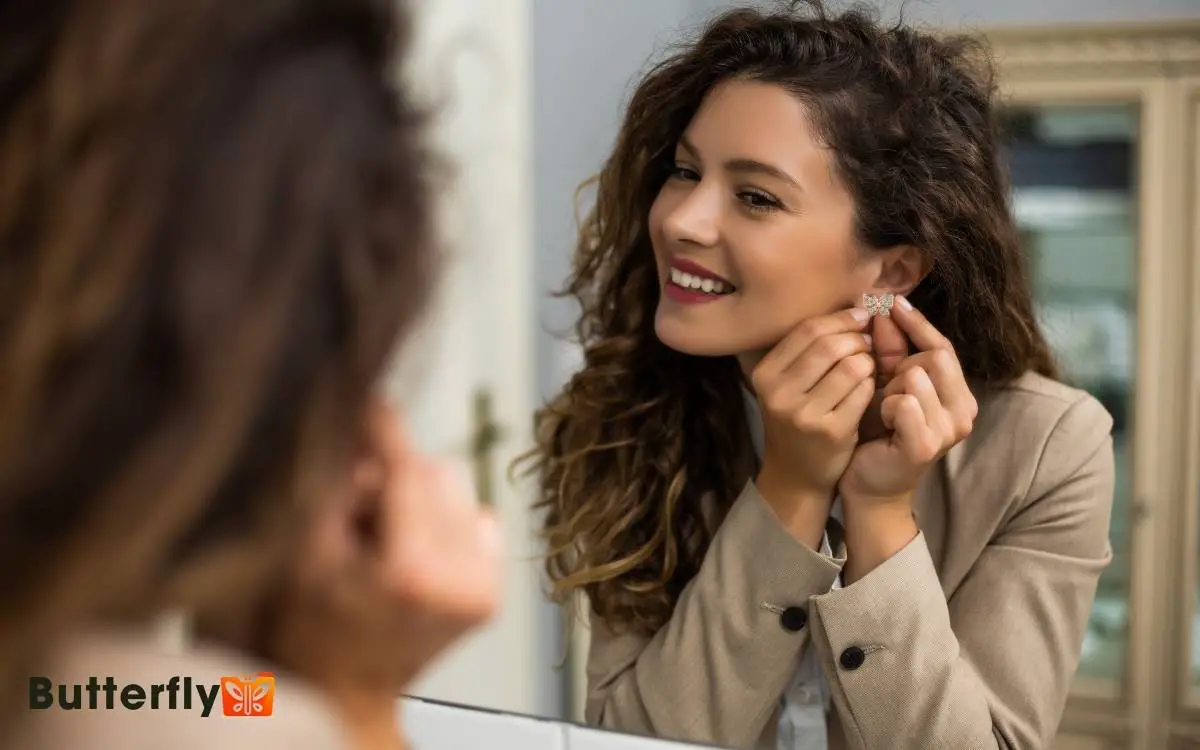How To Remove Butterfly Back Earrings? Simple Guide!
First, wash your hands to guarantee cleanliness. Gather necessary tools like a pair of tweezers. Position yourself in a well-lit area for better visibility.
Examine the earring for any potential issues. Firmly hold the front of the earring while gently pulling the butterfly back off. Utilize a gentle wiggle technique if the back is stubborn; avoid sudden movements to prevent damage.
After removal, inspect both the earring and your ear for any signs of damage or obstructions. Store the earrings safely. For more detailed insights and advanced tips, continue exploring this guide.

Key Takeaways
Wash Your Hands
Before removing your butterfly back earrings, make sure you wash your hands thoroughly to minimize the risk of introducing bacteria to the piercing site.
Utilize an antibacterial soap and lukewarm water, ensuring you scrub for at least 20 seconds. Pay special attention to the areas between your fingers and under your nails, where microbes tend to accumulate.
Rinse thoroughly and dry your hands with a clean, lint-free towel to avoid transferring any contaminants. This step is vital in maintaining the sterility of the procedure, preventing potential infections that could arise from improper hygiene.
A meticulous handwashing routine underscores the importance of precision and care, reflecting your commitment to both personal safety and innovative practices in ear care.
Gather Necessary Tools
Before you start, make sure you have essential tools like a pair of needle-nose pliers and a magnifying glass.
Set up a clean, well-lit workspace to avoid losing small components.
Having these preparations in place will facilitate a smoother earring removal process.
Essential Earring Removal Tools
You’ll need a pair of needle-nose pliers and a magnifying glass to effectively remove butterfly back earrings.
The needle-nose pliers offer precision and control, allowing you to grip the tiny backing without damaging the earring or your earlobe. Opt for pliers with a smooth, non-serrated surface to prevent scratching.
The magnifying glass is crucial for enhancing visibility, guaranteeing you can clearly see the intricate details of the earring mechanism. Choose a high-quality magnifying glass with at least 5x magnification for best clarity.
Additionally, consider having a pair of latex gloves to maintain a sterile environment and improve grip.
Preparing a Clean Workspace
Having gathered your needle-nose pliers, magnifying glass, and latex gloves, now arrange these tools on a clean, well-lit workspace to facilitate a smooth earring removal process. Position a lint-free cloth or silicon mat to prevent tools from slipping.
Ensure adequate lighting by using a high-lumen desk lamp to minimize shadows, enhancing visibility for precise maneuvers. Sterilize the workspace by wiping down surfaces with isopropyl alcohol; this will eliminate potential contaminants, ensuring a sterile environment.
Organize your tools within arm’s reach to streamline the removal process, reducing unnecessary movements.
By preparing your workspace meticulously, you not only enhance efficiency but also uphold the highest standards of hygiene and precision, pivotal for a successful earring removal experience.
Find a Well-Lit Area
Make sure you find a well-lit area to perform the task, as ideal lighting conditions are essential. This setup prevents shadows from forming, which can obscure your view and make the process more challenging.
Enhanced visual clarity will allow you to see the butterfly back earrings clearly, reducing the risk of mishandling.
Optimal Lighting Conditions
Proper illumination is crucial when removing butterfly back earrings to prevent mishandling and potential injury. Position yourself in a well-lit area, such as near a window with ample natural light or under a high-quality LED lamp.
Guarantee the light source provides uniform brightness and minimizes glare, enhancing your visual acuity and precision. Utilize task lighting with adjustable angles to target the earring and backing directly, facilitating meticulous removal.
For best results, choose a light with a color temperature around 5000K, simulating daylight and rendering colors accurately. This setup allows you to clearly see intricate details, reducing the risk of accidental slippage or damage.
Prioritize lighting to ensure a safe and efficient earring removal process.
Prevent Shadows Formation
Positioning yourself in a well-lit area helps prevent the formation of shadows, guaranteeing you can see the earring and backing clearly.
Adequate illumination enhances visibility, reducing the risk of fumbling or damaging the delicate mechanism. Prioritize using multiple light sources to achieve balanced lighting and eliminate any dark spots.
- Task lighting: Use a desk lamp or a ring light to direct focused light onto your earlobe.
- Ambient lighting: Ensure the room’s general lighting is bright enough to support detailed tasks.
- Natural lighting: Position yourself near a window during daytime to leverage sunlight, which offers superior clarity.
Enhance Visual Clarity
Perfect visual clarity is essential, so find a brightly lit area to guarantee you can see the earring and its backing with precision.
Ambient light sources may suffice, but consider using a focused LED task lamp for best illumination. Position the light to minimize shadows that could obscure critical details.
High-intensity lighting enables you to discern the minute mechanics of the butterfly back earring, allowing for precise manipulation without fumbling.
If you’re working with intricate designs or delicate materials, enhanced visibility reduces the risk of damage. Remember, the aim is to maintain control and accuracy throughout the removal process.
Examine the Earring
Examine the earring closely to pinpoint the butterfly back mechanism and confirm it’s intact and properly aligned. Pay attention to the structural integrity, ensuring no bends or distortions compromise its functionality.
- Position Verification: Guarantee the post and butterfly back are perfectly perpendicular.
- Attachment Security: Confirm the butterfly back is securely fastened, not loose or off-center.
- Material Condition: Inspect for any wear or damage, such as metal fatigue or corrosion.
Your meticulous assessment is vital for smooth removal. A misaligned or damaged butterfly back can complicate the process, risking potential harm to the earring or your earlobe.
This technical precision ensures you’re prepared for the next steps, maximizing efficiency and safety in earring removal.
Hold the Earring Steady
Firmly grip the front of the earring between your thumb and forefinger to stabilize it before attempting to remove the butterfly back. Hold the back of the earring with your other hand and gently wiggle it back and forth until it loosens. If the butterfly back feels stuck, try rotating it slightly while maintaining a steady grip on the front. For those interested in crafts, learning how to make a pipe cleaner butterfly can be a fun and creative activity.
Ensuring the earring is held securely prevents unnecessary movement, thereby reducing the risk of damage to both the earring and your earlobe.
Use a precise and steady hand to maintain control over the earring’s position. Focus on applying consistent pressure to avoid slippage, which could complicate the removal process.
Being meticulous with this step not only enhances the efficacy of your efforts but also underscores a commitment to maintaining the integrity of your jewelry.
Grip the Butterfly Back
Gently grasp the butterfly back using your index finger and thumb to guarantee a secure hold. Make sure your grip is firm yet delicate to prevent damaging the earring or your earlobe. Precision is key when handling delicate jewelry components.
To achieve the best results, make sure the following:
- Clean Hands: Confirm your hands are clean to avoid transferring oils or dirt onto the earring.
- Proper Lighting: Work in a well-lit area to clearly see the earring and its back.
- Stable Position: Keep your head and hand steady to minimize movement and provide better control.
Employ these strategies to maintain the integrity of both the butterfly back and the earring post, ensuring a seamless removal process.
Apply Gentle Pressure
Once you’ve secured a firm grip on the butterfly back, apply gentle, consistent pressure to slide it off the earring post. Make sure your thumb and index finger are positioned to distribute force evenly, minimizing potential deformation.
The butterfly back’s tension should yield gradually, preventing abrupt movements that could damage the delicate post or the earring itself. Maintain a steady hand, avoiding any sudden jerks that might compromise the earring’s structural integrity.
As you apply pressure, focus on keeping the movement linear, aligned with the post’s axis. This method not only guarantees a smooth removal but also preserves the longevity of both the earring and its back.
Wiggle the Back Loose
You should employ the gentle wiggle technique to gradually loosen the butterfly back.
Avoid any sudden movements to prevent damage to the earring or your earlobe.
Always check for any obstructions that might impede removal, ensuring a smooth and safe process.
Gentle Wiggle Technique
By applying a consistent and controlled back-and-forth motion, you can effectively loosen the butterfly back earring without causing damage to the post or discomfort to the ear.
Grip the earring post securely with one hand while gently wiggling the butterfly back with the other. Make sure you maintain an even pressure to prevent any abrupt movements.
- Firm Grip: Hold the earring post steadily to guarantee stability.
- Gentle Wiggle: Execute a subtle, alternating motion to gradually release the backing.
- Consistent Pressure: Apply uniform force for a smooth, damage-free removal.
- The aim here is precision and control, ensuring each motion contributes to loosening the backing without risking structural integrity. This technique is ideal for minimizing discomfort while maintaining the earring’s pristine condition.
Avoid Sudden Movements
Maintaining a steady, controlled motion is vital to prevent sudden movements that could cause discomfort or damage to the earring post.
To effectively wiggle the back loose, apply consistent, gentle pressure while holding the earring stud and back. Utilize a sequential, alternating motion between slight rotations and minimal pulls.
This approach guarantees the butterfly back gradually loosens without exerting excessive force that could compromise the integrity of the earring post or the ear lobe.
Pay attention to tactile feedback; if resistance increases, reassess your technique to avoid unnecessary strain.
Implementing a methodical, deliberate strategy not only preserves the structural integrity of your earrings but also maximizes comfort and efficiency in the removal process.
Check for Obstructions
With a steady motion established, now inspect the earring for any obstructions that might impede the removal process. Carefully examine the area around the butterfly back.
Confirm there are no small tangles or debris that could obstruct a smooth removal. Utilize a gentle wiggling technique to help loosen the back without applying excessive force.
- Check for any visible buildup of dirt or grime.
- Confirm the earring post isn’t bent or damaged.
- Verify that the butterfly back isn’t stuck to your ear or earring.
These steps are crucial to prevent potential damage to both the earring and your earlobe. By identifying and addressing any obstructions, you’ll facilitate a more efficient and safe removal process, maintaining the integrity of your jewelry.
Pull the Back Off
Start by firmly gripping the front of the earring to stabilize it while you gently pull the butterfly back off. Use your thumb and index finger to apply steady pressure on the butterfly clasp.
Maintain a consistent, gentle pull to prevent any deformation of the metal. Guarantee your movements are controlled to avoid accidental slippage that could damage the earring or your earlobe.
The butterfly back should slide off smoothly if no obstructions are present. If resistance is encountered, recheck for any misalignment or debris. Remember, precision is key to maintaining the integrity of both the earring and the clasp.
This method ensures a seamless removal process, keeping your jewelry in excellent condition.
Remove the Earring
Gently hold the earring’s front piece before you carefully slide it out through the piercing to avoid any unnecessary discomfort or potential injury.
Confirm your hands are steady and clean to minimize contamination risks. Maintain a slow, consistent motion to keep the process seamless.
- Grip Precision: Use your thumb and forefinger to hold the earring’s stud securely.
- Angle Awareness: Align the earring with the piercing’s natural angle to prevent tissue damage.
- Controlled Motion: Employ a smooth, controlled pull to facilitate a painless removal.
Inspect for Damage
After removing the earring, examine the stud and butterfly back closely for any signs of bending, warping, or damage that could compromise their integrity.
Utilize a jeweler’s loupe to scrutinize the metal for micro-fractures or stress points. Inspect the prongs to make sure they’re firmly grasping the gemstone, preventing potential dislodgment.
Pay attention to the butterfly back’s tension; it should securely clasp the stud. If you detect any anomalies, consider employing precision tools to rectify minor bends or seek professional repair.
This meticulous inspection prevents gradual degradation, ensuring your earrings maintain top-notch functionality and aesthetic appeal.
Your commitment to detail will prolong the lifespan of your jewelry, aligning with the innovative standards you value.
Store Earrings Safely
Proper storage of your butterfly back earrings is essential to preserving their structural integrity and preventing loss or damage. Utilize specialized storage solutions to maintain their condition.
Employ a jewelry box with compartments to avoid tangling, or consider a dedicated earring organizer to keep pairs together.
- Anti-tarnish strips: Place these in your storage box to protect metal components from oxidation.
- Microfiber pouches: Use these to store individual earrings, preventing scratches and moisture exposure.
- Custom foam inserts: These tailor-fit inserts can cradle your earrings securely, mitigating movement and friction.
Conclusion
With your hands freshly washed and tools neatly arranged, you carefully remove the butterfly back earring under the bright light. You feel the smooth metal as you pull the back off, revealing the earring’s delicate structure.
Once removed, you inspect for any signs of damage, ensuring the precious piece remains pristine.
Finally, you store your earrings safely, nestled in their designated compartments, ready to dazzle again. Precision and care have preserved their beauty for future wear.






